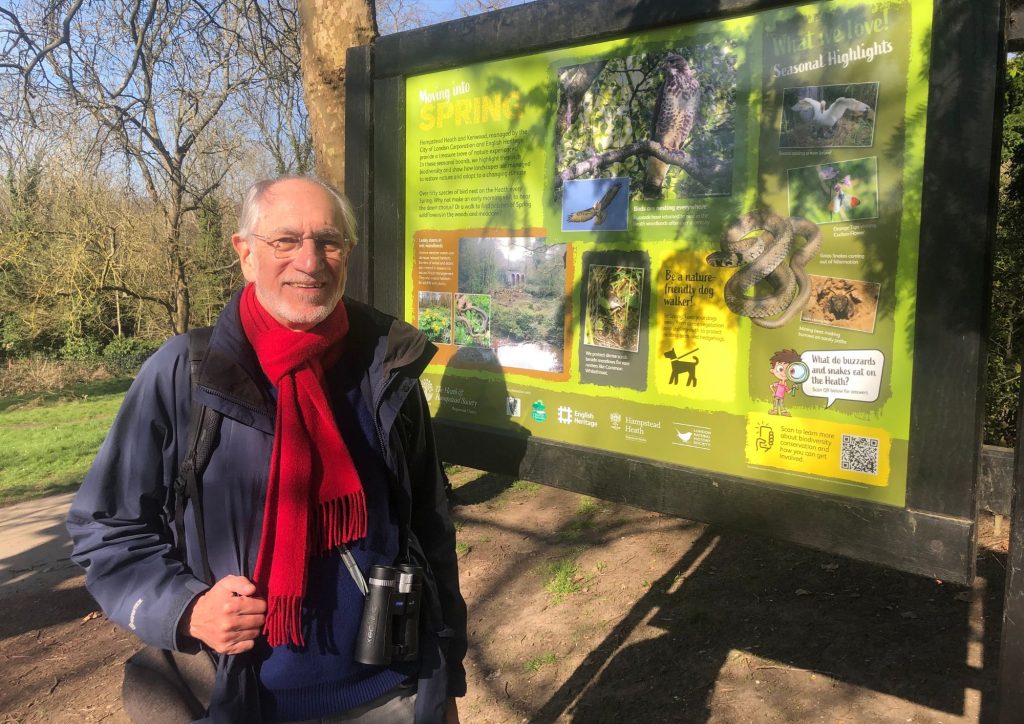After 100 years, the buzzards are back!
Ecologists find nesting pair on Hampstead Heath
Thursday, 27th March — By Dan Carrier

A buzzard on Hampstead Heath
WITH a majestic wingspan, a soaring buzzard riding the wind as it scans the ground for prey is one of those special sights that thrill birdwatchers.
And now twitchers – as birdwatchers are known – can feast their eyes on the birds by taking an early morning stroll on Hampstead Heath.
While they are now protected, in days gone by gamekeepers would shoot, poison and wreck their nests to protect stocks of game birds for landowners to shoot.
It drove the buzzard to areas like Snowdonia and Cumbria – but in recent years they have been creeping back eastwards across England, and have now found a forever home on Heath.
Ecologists have confirmed this week to the New Journal there is one nesting pair on the open space. Heath records show that the last time buzzards nested here was 100 years ago.

Dr Jeff Waage om Hampstead Heath
Heath ecologist Dr Jeff Waage monitors wildlife on the open space, and told the New Journal how the birds’ appearance show a healthy open space.
Dr Waage said: “They are remarkable – they are really big birds of prey. The Heath is one of the few places in London with a healthy rabbit population, but they also eat voles, rats and mice. Coupled with plenty of tall trees and woodland, it makes the Heath a desirable location for the buzzard.”
Buzzards build nests from twigs and prefer to be as high up as they can. It is likely, Mr Waage adds, that they have found a place to call home in pine trees in Kenwood.
He said: “They can really hide in pines because the needles are very dense.” Last summer, young buzzards were spotted in the West Meadow in Kenwood. Dr Waage added: “They have a very distinctive call and can make a real racket. The best time to spot one is early in the morning. They do not hover like kestrels but can be seen circling, riding updrafts.”
As an apex predator, the buzzard’s appearance on the Heath helps ecologists monitor wildlife. Mr Waage said: “It is fantastic to think the Heath is wild enough to support a bird of prey.”
And the Heath is home to other airborne hunters: kestrels, sparrow hawks, peregrine falcons and hobby hawks also nest there. Dr Waage said: “Over 50 bird species breed here every spring and our seasonal information boards tell walkers about the range of wildlife the open space supports.”
Help on the Heath
WHEN hungry diners sought exotic crayfish on the menus of Hampstead restaurants, one chef had a bright idea: to avoid the costs of buying imported Texan and Louisiana crayfish from Billingsgate each day, the restaurant employee took some pairs of the red-clawed carapaces – known as Mud Bugs in the USA – and dumped them in ponds on Hampstead Heath.
The plan was to be able to return with nets and harvest their own. Now, 75 years later, the crayfish are well established on the Heath.
They are just one species of a number Heath walkers can spot – and this week, new information boards have been placed on the open space pointing out flourishing wildlife.
The guide tells walkers to keep an eye out for grass snakes, which were introduced in the 1950s after being moved from a patch of open land in central London.
Terrapins and turtles also enjoy the ponds.
Discarded as unwanted pets, there is no evidence they are breeding – but turtles have a long lifespan and ecologists have spotted varieties including the European pond turtle.
Mr Waage said: “They eat native wildlife but are difficult to catch, so they remain in the ponds.”